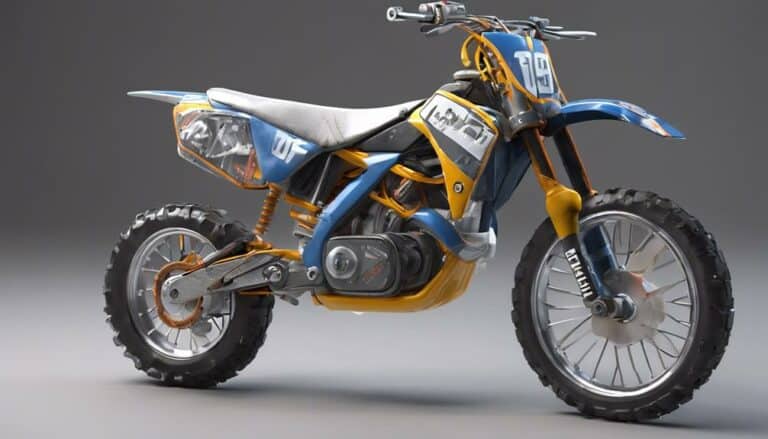To assess a dirt bike's electrical system, you need a digital multimeter, test light, sandpaper, and contact cleaner spray. Use the multimeter for voltage testing, check battery, stator, and ignition coil. An ohmmeter helps with ignition coil checks, verifying resistance values. Guarantee continuity using the multimeter to detect broken wires. Correct tool usage is vital. Test light and multimeter are essential for safety and system health. These tools aid in effective evaluation and maintenance, ensuring your dirt bike operates at its best.
Key Takeaways
- Digital multimeter for voltage testing and system operational insights.
- Ohmmeter for ignition coil resistance values examination.
- Continuity testing with multimeter for wire and connection integrity.
- Test light for power presence and continuity checks.
- Proper tool usage essential for safety and accurate assessments.
Essential Tools for Assessment
To evaluate a dirt bike's electrical system effectively, you must equip yourself with essential tools such as a digital multimeter and a test light. These testing tools are pivotal for diagnosing issues within the electrical components of the bike. Before delving into the assessment, it's important to confirm the battery terminals are clean and free of corrosion. Using fine sandpaper to clean the terminals will ensure a solid connection for accurate readings during testing.
Additionally, utilizing contact cleaner spray on plugs and connectors will help eliminate any dirt or corrosion that could impede the flow of electricity within the system. By starting with clean and well-connected battery terminals, you set yourself up for successful testing procedures with the multimeter and test light. These tools will aid in pinpointing any faults such as broken wires or faulty connections that may be causing electrical issues in your dirt bike. Proper maintenance of these tools and components is key to keeping your bike running smoothly.
Digital Multimeter for Voltage Testing
Start by utilizing a digital multimeter for conducting voltage testing on your dirt bike's electrical system to accurately diagnose any charging system issues and assess key components such as the battery, stator, and ignition coil.
The multimeter is an essential tool that allows you to measure the voltage across these components, providing valuable insights into their operational status.
When testing the battery voltage, make sure the bike is off, and connect the multimeter to the battery terminals to check if it's within the expected range.
For the stator, set the multimeter to the AC voltage setting and connect it to the stator wires to verify the output values.
To assess the ignition coil, switch the multimeter to the ohms setting and measure the resistance across the ignition coil terminals.
Understanding these readings will help you pinpoint any issues affecting your dirt bike's electrical system accurately.
Ohmmeter for Ignition Coil Inspection
When examining the ignition coil's resistance values on your dirt bike's electrical system, an ohmmeter is a crucial tool to utilize effectively. To accurately measure the coil's resistance, set the ohmmeter to the lowest setting.
Check the specified ohm values across the ignition coil's terminals to guarantee proper functionality. Verify the resistance across the plug terminals to confirm the ignition coil is in good condition.
By using an ohmmeter, you can efficiently diagnose any ignition coil issues that may be impacting your dirt bike's electrical system. This method of testing allows you to pinpoint any problems with the ignition coil, helping you troubleshoot and address them promptly.
Make sure to follow the manufacturer's specifications for resistance values and compare them to your ohmmeter readings for a thorough assessment of your dirt bike's ignition coil.
Continuity Testing With Multimeter
For efficient identification of broken wires or faulty connections in your dirt bike's electrical system, a crucial tool to utilize is a multimeter set to the continuity setting. When conducting continuity testing with a multimeter, you're basically checking if there's an unbroken path for electrical current flow between different points in the electrical system. By setting your multimeter to the continuity (waveform icon) setting, you can easily determine if connections are intact or if there are any broken wires disrupting the flow of electricity.
To perform the test, simply place the multimeter probes at the two points you want to check for continuity. If there's a continuous path, the multimeter will emit a sound or display a reading indicating the presence of a connection. If there's no continuity, it suggests a break in the circuit, requiring further inspection to locate and rectify the issue. This method helps pinpoint areas in the electrical system that require attention, ensuring top-notch performance of your dirt bike.
Importance of Correct Tool Usage
Correct tool usage is paramount for accurately evaluating a dirt bike's electrical system and ensuring efficient troubleshooting. When working on dirt bikes, using tools like a test light and a multimeter is essential. These tools help in identifying power presence, continuity, voltage, resistance, and other essential measurements within the electrical system. Below is a table showcasing the importance of proper tool usage when evaluating a dirt bike's electrical system:
| Tool | Function |
|---|---|
| Test Light | Identifies power presence and continuity in the system |
| Multimeter | Provides precise voltage, resistance, and continuity readings |
| Proper Usage | Guarantees safety and prevents damage to the bike's system |
| Familiarity | Key for effective evaluation and maintenance of the system |
Conclusion
To sum up, without the essential tools for evaluating a dirt bike's electrical system, you might as well be trying to fix a spaceship with a toothpick.
Proper diagnosis and troubleshooting rely heavily on the accurate readings provided by tools like digital multimeters and ohmmeters.
So, don't underestimate the importance of having the correct tools on hand when dealing with electrical issues on your dirt bike. It's like trying to navigate a dark cave without a flashlight – you'll just end up lost in the darkness.

